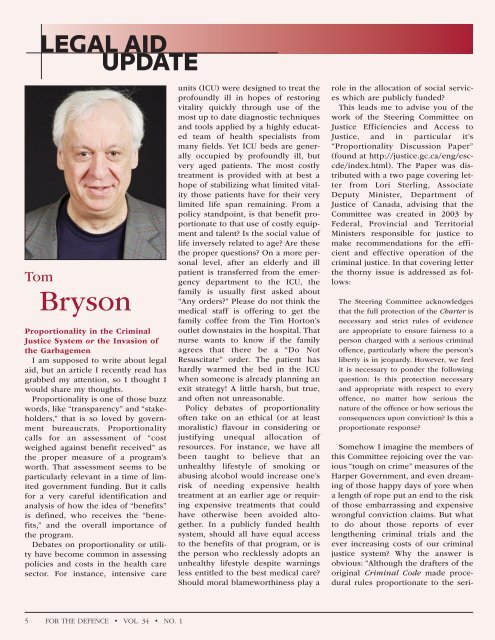FTD_Vol34_No3_web
FTD_Vol34_No3_web
FTD_Vol34_No3_web
Create successful ePaper yourself
Turn your PDF publications into a flip-book with our unique Google optimized e-Paper software.
For the Defence_34-3_Layout 1 13-08-16 10:40 AM Page 5<br />
LEGAL AID<br />
UPDATE<br />
Tom<br />
Bryson<br />
Proportionality in the Criminal<br />
Justice System or the Invasion of<br />
the Garbagemen<br />
I am supposed to write about legal<br />
aid, but an article I recently read has<br />
grabbed my attention, so I thought I<br />
would share my thoughts.<br />
Proportionality is one of those buzz<br />
words, like “transparency” and “stakeholders,”<br />
that is so loved by government<br />
bureaucrats. Proportionality<br />
calls for an assessment of “cost<br />
weighed against benefit received” as<br />
the proper measure of a program’s<br />
worth. That assessment seems to be<br />
particularly relevant in a time of limited<br />
government funding. But it calls<br />
for a very careful identification and<br />
analysis of how the idea of “benefits”<br />
is defined, who receives the “benefits,”<br />
and the overall importance of<br />
the program.<br />
Debates on proportionality or utility<br />
have become common in assessing<br />
policies and costs in the health care<br />
sector. For instance, intensive care<br />
units (ICU) were designed to treat the<br />
profoundly ill in hopes of restoring<br />
vitality quickly through use of the<br />
most up to date diagnostic techniques<br />
and tools applied by a highly educated<br />
team of health specialists from<br />
many fields. Yet ICU beds are generally<br />
occupied by profoundly ill, but<br />
very aged patients. The most costly<br />
treatment is provided with at best a<br />
hope of stabilizing what limited vitality<br />
those patients have for their very<br />
limited life span remaining. From a<br />
policy standpoint, is that benefit proportionate<br />
to that use of costly equipment<br />
and talent? Is the social value of<br />
life inversely related to age? Are these<br />
the proper questions? On a more personal<br />
level, after an elderly and ill<br />
patient is transferred from the emergency<br />
department to the ICU, the<br />
family is usually first asked about<br />
“Any orders?” Please do not think the<br />
medical staff is offering to get the<br />
family coffee from the Tim Horton’s<br />
outlet downstairs in the hospital. That<br />
nurse wants to know if the family<br />
agrees that there be a “Do Not<br />
Resuscitate” order. The patient has<br />
hardly warmed the bed in the ICU<br />
when someone is already planning an<br />
exit strategy! A little harsh, but true,<br />
and often not unreasonable.<br />
Policy debates of proportionality<br />
often take on an ethical (or at least<br />
moralistic) flavour in considering or<br />
justifying unequal allocation of<br />
resources. For instance, we have all<br />
been taught to believe that an<br />
unhealthy lifestyle of smoking or<br />
abusing alcohol would increase one’s<br />
risk of needing expensive health<br />
treatment at an earlier age or requiring<br />
expensive treatments that could<br />
have otherwise been avoided altogether.<br />
In a publicly funded health<br />
system, should all have equal access<br />
to the benefits of that program, or is<br />
the person who recklessly adopts an<br />
unhealthy lifestyle despite warnings<br />
less entitled to the best medical care?<br />
Should moral blameworthiness play a<br />
role in the allocation of social services<br />
which are publicly funded?<br />
This leads me to advise you of the<br />
work of the Steering Committee on<br />
Justice Efficiencies and Access to<br />
Justice, and in particular it’s<br />
“Proportionality Discussion Paper”<br />
(found at http://justice.gc.ca/eng/esccde/index.html).<br />
The Paper was distributed<br />
with a two page covering letter<br />
from Lori Sterling, Associate<br />
Deputy Minister, Department of<br />
Justice of Canada, advising that the<br />
Committee was created in 2003 by<br />
Federal, Provincial and Territorial<br />
Ministers responsible for justice to<br />
make recommendations for the efficient<br />
and effective operation of the<br />
criminal justice. In that covering letter<br />
the thorny issue is addressed as follows:<br />
The Steering Committee acknowledges<br />
that the full protection of the Charter is<br />
necessary and strict rules of evidence<br />
are appropriate to ensure fairness to a<br />
person charged with a serious criminal<br />
offence, particularly where the person’s<br />
liberty is in jeopardy. However, we feel<br />
it is necessary to ponder the following<br />
question: Is this protection necessary<br />
and appropriate with respect to every<br />
offence, no matter how serious the<br />
nature of the offence or how serious the<br />
consequences upon conviction? Is this a<br />
proportionate response?<br />
Somehow I imagine the members of<br />
this Committee rejoicing over the various<br />
“tough on crime” measures of the<br />
Harper Government, and even dreaming<br />
of those happy days of yore when<br />
a length of rope put an end to the risk<br />
of those embarrassing and expensive<br />
wrongful conviction claims. But what<br />
to do about those reports of ever<br />
lengthening criminal trials and the<br />
ever increasing costs of our criminal<br />
justice system? Why the answer is<br />
obvious: “Although the drafters of the<br />
original Criminal Code made procedural<br />
rules proportionate to the seri-<br />
5 FOR THE DEFENCE • VOL. 34 • NO. 1<br />
FOR THE DEFENCE • VOL. 34 • NO. 3<br />
5



